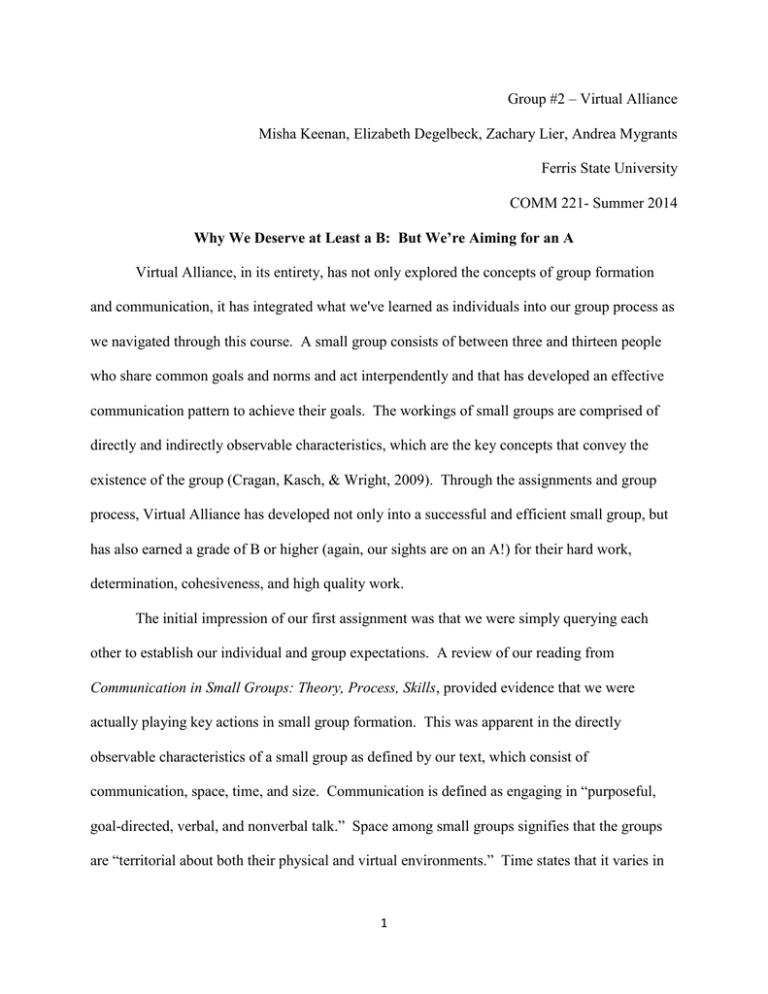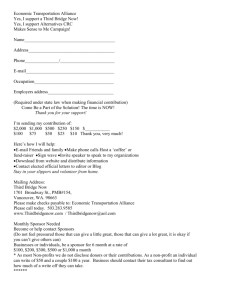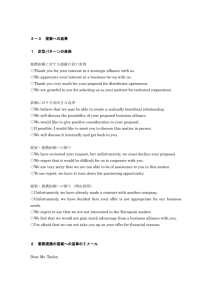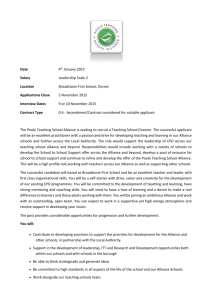File - Elizabeth Degelbeck
advertisement

Group #2 – Virtual Alliance Misha Keenan, Elizabeth Degelbeck, Zachary Lier, Andrea Mygrants Ferris State University COMM 221- Summer 2014 Why We Deserve at Least a B: But We’re Aiming for an A Virtual Alliance, in its entirety, has not only explored the concepts of group formation and communication, it has integrated what we've learned as individuals into our group process as we navigated through this course. A small group consists of between three and thirteen people who share common goals and norms and act interpendently and that has developed an effective communication pattern to achieve their goals. The workings of small groups are comprised of directly and indirectly observable characteristics, which are the key concepts that convey the existence of the group (Cragan, Kasch, & Wright, 2009). Through the assignments and group process, Virtual Alliance has developed not only into a successful and efficient small group, but has also earned a grade of B or higher (again, our sights are on an A!) for their hard work, determination, cohesiveness, and high quality work. The initial impression of our first assignment was that we were simply querying each other to establish our individual and group expectations. A review of our reading from Communication in Small Groups: Theory, Process, Skills, provided evidence that we were actually playing key actions in small group formation. This was apparent in the directly observable characteristics of a small group as defined by our text, which consist of communication, space, time, and size. Communication is defined as engaging in “purposeful, goal-directed, verbal, and nonverbal talk.” Space among small groups signifies that the groups are “territorial about both their physical and virtual environments.” Time states that it varies in 1 “how long it takes them to become a true group and how they manage their time.” A small group size is minimally three members, the ideal is five to seven, and the maximum is 13 (Cragan, Kasch & Wright, 2009, p. 10). We met these characteristics by: making our questions purposeful and goal directed; we defined the space where we would work as our group discussion board; we discussed the importance of being on time with our assignments and that this is a mutual expectation, and we meet the size requirements of a small group by having 4 members. As Virtual Alliance developed, we exhibited the five indirectly observable characteristics throughout the semester which can also be seen throughout this paper. These characteristics consist of interdependence, group norms, structural patterns of talk, goals, and a perceived shared identity (Cragan, Kasch, & Wright, 2009). As we progressed, and our interdependence strengthened, we explored the ways in which our group of four individuals would utilize their identified strengths to balance out the weaknesses of the other members and advance the group as a cohesive unit. Even without discussion, it was clear that each of us identified with and assumed certain “group roles.” Our group, at its genesis, consisted of two task leaders who were the starters, a social-emotional leader who addressed our need to be included and was able to give support to the leaders and our projects, and a central negative who was able to analyze our work and make sure we were covering all of the bases. It seems that we shared the tension releaser, information provider and central negative roles. Interestingly, the group roles assumed originally morphed over time as the needs of the group altered. Those who were less likely to lead in the beginning, for instance, were able to recognize opportunities to take charge as their comfort level increased. Those who once led, were able to hand over the reins in certain situations and assume a more supporting role in order for everyone to have an opportunity to participate in ways that were meaningful to them 2 individually yet produce solid group results. As our group norms were established, our priorities became putting out a high quality product, assuring that each member's input was valued, that we all shared equally in creating the end result, being considerate and timely out of respect for each other. The creation of our team identity package was the pivotal task in which we were producing group work rather than projects created from the sum of individual parts. Up to this point in our experience with group work, many of us had conquered group work by dividing assignments into equal and manageable parts, convening before the due date and compiling our work. For this course, we were challenged to find a way to work as one cohesive unit. We accomplished this by using the group discussion board and wiki to virtually work as a unit, posting each change or idea as we went along, allowing each member to comment, revise and edit the product until we came to a collaborative final decision that the project was completed to our satisfaction. We successfully used Fundamental Interpersonal Relations Orientation (FIRO) to analyze observed personalities within our group. In doing so, we were able to recognize the individual needs of group members and use them to strengthen our communication. As we recognized our individual needs for Inclusion, Control and Affection, we began to understand that we would each contribute in various ways and though our specific means were different, they were in no way wrong. In fact, each of these became essential to our group work as we began to know what to expect from the individuals with whom we were tasked to work. For instance, while our group was overall a social unit, we understood that some members tended toward undersocial and in order to elicit their inpu,t they needed prompting. While our group was primarily a democratic body, some members had autocratic tendencies when it came to getting projects 3 started and sorted out. Others were abdicatratic, comfortable with the general concensus, again, participating when prompted. The need for affection and openness did not seem to affect our virtual group the way it may have had we been meeting face to face. Individually, we’ve been members of groups in which an overpersonal member takes over the allotted work time, filling every silence with chit chat about him or herself, commenting upon everything that is said during discussion, impeding the group’s ability to stay on task. The individual members of our group, perhaps because of its virtual nature, exhibited for the most part ideal personal traits. Virtual Alliance was able to, generally, cut to the core of each challenge and get the job done without much unnecessary vocalization from an overpersonal or neglect from an underpersonal member. As we outlined the presentation for self-centered behaviors, we became aware as a team of certain characteristics that may be detrimental to working in a small group, as well as communication skills would potentially enhance effective role performance. We have managed to avoid the self-centered follower role characteristics including aggressing, doormatting, eggheading, airheading, complaining, self-confessing, help seeking recognition seeking, specialinterest pleading, playing the clown, blocking, and foddering. Instead, we have matured into effective participants and provide leadership when needed for improved performance. We actively listen to each member’s input, assist in deficient areas, and encourage each other to stay focused in order to achieve increased productivity and goals. As previously discussed, Virtual Alliance has proven through the groups tasks, that they have exceled in becoming and working together as a group. Through the leadership, power, and conflict surveys, the group has also became aware of how they function independently and how these behaviors act interdependently with the group. Group conflict when it arose, was easily manageable through our enhanced communication skills. We found that by maintaining a spirit 4 of inquiry and encouraging reciprocal communication, we portrayed effective task managing skills. We also avoided deviant interpersonal behaviors to create excellent relationshipmanaging skills and built group pride through multiple compliments on group member’s work effort. We were able to accommodate to everyone’s busy and varied schedules, collaborated in all of our assignments, and compromised when a decision could not be made. One of the strengths of Virtual Alliance is its adaptability. Despite our propensities for certain roles and styles, each group member demonstrated the ability to navigate through a variety of group roles, communication, leadership and conflict styles as our group progressed through the course. We believe this ability contributed greatly to our success as a whole. Our individual contributions however, are not to be dismissed. Liz demonstrated from the very beginning that she was able to lead the group. She brought many exceptional communication skills and prior experience working in groups. Her strengths developed throughout our work as she frequently assumed the role of group leader and information provider. Liz held true to her initial assertions of consideration and respect for the group and its members. Throughout the term, frequently Liz was our cheerleader and guide. The amount of input and information she contributed was outstanding. Liz's democratic style created an atmosphere in which she could give suggestions and elicit feedback from the rest of the group for a true collaboration. Andrea played an essential supporting role for our group. She stepped up when needed to start or finish projects and provided the group with reliable information. Her communication was effective and appropriate and accommodated to the group where it was required. She helped support the best ideas from the group and spoke up if she disagreed and provided the group with constructive feedback. She was not afraid to ask for guidance and offered her own guidance to 5 other group members needing assistance. She shared her workload and offered mature problem solving skills by seeking information and opinions and examining the advantages and disadvantages of solutions. Zach struggled at the start of the course because of lack of knowledge about online courses and communication that was needed in them. After these needs became apparent he fell into the role of follower, exhibiting abdicratic tendencies in the group and grew in his strengths in that role. Zach began gaining confidence and communicated more and more with the helpful encouragement of his group members. Zach helped a lot with review and editing of projects where thorough work came in handy. Zach exerted his power in the group through expert means by giving sound advice and helpful hints which strengthen overall productivity. Misha provided excellent democratic co-leadership skills. She made sure that tasks were turned in in a timely manner and acquired referent and expert power through the semester. She provided thorough and high quality input and collaborated throughout the assignments to achieve the group’s goals. Also, she asked valuable questions to assist other team members in brainstorming for projects. If conflict were to arise, such as a member not participating, she would take it upon herself to inquire about the lack of participation, which would quickly resolve the tension and conflict within the group. She played an integral role in our group and assisted in maintaining the cohesiveness of the group for increased productivity and high quality work. For these reasons, and countless more, Virtual Alliance and its individual members have earned a grade of at least a B (though we all believe an A is in order) in this class. We have understood the importance of and followed the ten commitments in our small group. We have done our best and performed well for the group. We were rational, played fairly, listened, prepared, exhibited ideational conflict, committed to objectivity and tolerance, and had a sense of 6 social maturity. We have learned as much from each other as we have from the class content and are satisfied that the skills we take with us on our individual journeys will be of great benefit to our families and friends, fellow students, co-workers and the organizations to which we accept membership. While we come from different locales, careers and walks of life, and it is unlikely that our paths will cross in the future, we will take Virtual Alliance with us into the future as a tool with which to make positive change in our environments. 7 References Cragan, J. F., Kasch, C. R., & Wright, D. W. (2009). Communication in small groups: Theory, process, skills (7th ed.). Boston, MA: Wadsworth Cengage Learning. 8







